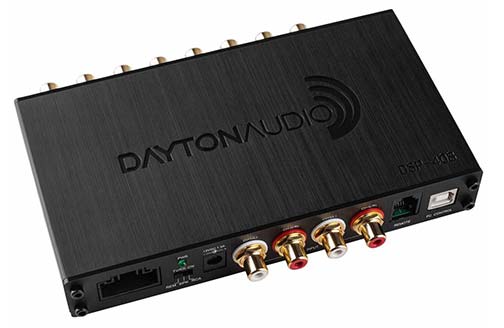Factory stereos are designed to handle OEM speakers. But when you upgrade to aftermarket amps, subs and speakers, a high-quality head unit is needed to calibrate these powerful devices.
But many times, replacing a factory head unit is not easy as many essential car systems are connected to it. If that is the case, you can place between the head unit and amp to negate the shortcomings.
A Digital Signal Processor (DSP) is a component used to tweak the car audio.
Not so long ago, we used to have analog crossovers and equalizers for calibrating and altering the sound signals through their sliders/knobs.
Main issues this approach had were an inaccurate adjustment, time consumption, and repeatability. Being a digital device, DSPs don’t face any of these issues. And after making any changes, you can save those settings in your PC for further use.
What is a DSP in Car Audio?
You can consider DSP as an all-round package that comes with a built-in crossover, equalizer, line output converter, and a line driver. Below we’ll discuss the main features you get in a DSP these days.
1. DSP Controls – Knobs vs Software
There are two kinds of DSP. The first ones come with onboard controls, meaning you can tweak settings on the go. The biggest disadvantages such DSPs have is that need to be physically accessible – something not possible if you’ve placed it in hard-to-reach areas, such as under a seat.
The other DSP type is the one that can be controlled by PC/tablet/smartphone via software. You can connect to these DSPs via USB or Bluetooth connection, and make changes through companion software/apps. These DSPs are very convenient but you would need a PC/smartphone every time you want to make any adjustment.
2. Power Options
Some amplifiers come with built-in DSPs. So if you’re a beginner and want both of these devices, then such models would be ideal for you.
But the obvious downside is that if you ever decide to change your amp in the future, you’ll have to find a new DSP as well, and make all those changes again.
Having separate amps and DSPs give you much more flexibility in this regard.
3. Equalization
The closed nature of a car and different materials used in its interior can affect the sound – meaning your speakers will sound not as they were intended initially.
This issue can be solved by an equalizer. The equalizer allows you to control the sound frequencies far more than the bass and treble options on your factory stereo can.
The equalizer in a DSP can have as many as thirty different controls for each speaker, with each of them allowing you to fine-tune a very narrow bandwidth of that speaker. This way we can boost the frequencies that are dull, and reduce the ones that are overpowered.
3. Time Alignment
Sound travels in the form of waves, and unlike what many think, these waves travel at a relatively slower speed. Since different speakers in a vehicle are placed at a different distance from you, sound from each of them will reach to you at different times.
Although this difference is only in some milliseconds, it causes the soundstage to go off-balance and you’ll hear some parts of music more and some parts of it less.
This issue can be solved by using a feature called time alignment. All you need to do is calculate your distance from each of your car speakers, and then input those measurements into the DSP software.
This software will make the DSP delay the sound of closer speakers by some fractions of a second so that their sound comes at the same time as the sound from other distant speakers – centring the sound image and making it much more realistic.
4. Crossover
A crossover is a device that blocks unwanted frequencies from a full-range audio signal before sending the remaining frequencies to a speaker.
It removes the low frequencies for a tweeter and high frequencies for a sub, so that they can focus on high-end and low-end frequencies respectively. The remaining midrange frequencies are then sent to regular speakers, such as door speakers.
Many DSPs come with built-in crossovers that allow you to set up a filter for each of your speakers.
Do I need A DSP In My Car?
Whether you need a DSP or not depends on your current car audio setup. If you’re new to all this, you can skip it and currently focus on main components such as speakers, amps, and subs.
But if you have already upgraded all of these components, and are now looking to take your car audio to the next level, the DSP is worth a shot.
